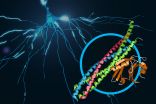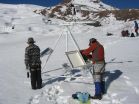(Press-News.org) Menlo Park, Calif. -- Scientists have revealed never-before-seen details of how our brain sends rapid-fire messages between its cells. They mapped the 3-D atomic structure of a two-part protein complex that controls the release of signaling chemicals, called neurotransmitters, from brain cells. Understanding how cells release those signals in less than one-thousandth of a second could help launch a new wave of research on drugs for treating brain disorders.
The experiments, at the Linac Coherent Light Source (LCLS) X-ray laser at the Department of Energy's SLAC National Accelerator Laboratory, build upon decades of previous research at Stanford University, Stanford School of Medicine and SLAC. Researchers reported their latest findings today in the journal Nature.
"This is a very important, exciting advance that may open up possibilities for targeting new drugs to control neurotransmitter release. Many mental disorders, including depression, schizophrenia and anxiety, affect neurotransmitter systems," said Axel Brunger, the study's principal investigator. He is a professor at Stanford School of Medicine and SLAC and a Howard Hughes Medical Institute investigator.
"Both parts of this protein complex are essential," Brunger said, "but until now it was unclear how its two pieces fit and work together."
Unraveling the Combined Secrets of Two Proteins
The two protein parts are known as neuronal SNAREs and synaptotagmin-1.
Earlier X-ray studies, including experiments at SLAC's Stanford Synchrotron Radiation Lightsource (SSRL) nearly two decades ago, shed light on the structure of the SNARE complex, a helical protein bundle found in yeasts and mammals. SNAREs play a key role in the brain's chemical signaling by joining, or "fusing," little packets of neurotransmitters to the outer edges of neurons, where they are released and then dock with chemical receptors in another neuron to trigger a response.
A 'Smoking Gun' for Neurotransmitter Release
In this latest research, the scientists found that when the SNAREs and synaptotagmin-1 join up, they act as an amplifier for a slight increase in calcium concentration, triggering a gunshot-like release of neurotransmitters from one neuron to another. They also learned that the proteins join together before they arrive at a neuron's membrane, which helps to explain how they trigger brain signaling so rapidly.
"The neuron is not building the 'gun' as it sits there on the membrane - it's already there," Brunger said.
The team speculates that several of the joined protein complexes may group together and simultaneously interact with the same vesicle to efficiently trigger neurotransmitter release, an exciting area for further studies.
"The structure of the SNARE-synaptotagmin-1 complex is a milestone that the field has awaited for a long time, and it sets the framework for a better understanding of the system," said James Rothman, a professor at Yale University who discovered the SNARE proteins and shared the 2013 Nobel Prize in Physiology or Medicine.
Thomas C. Südhof, a professor at the Stanford School of Medicine and Howard Hughes Medical Institute investigator who shared that 2013 Nobel Prize with Rothman, discovered synaptotagmin-1 and showed that it plays an important role as a calcium sensor and calcium-dependent trigger for neurotransmitter release.
"The new structure has identified unanticipated interfaces between synaptotagmin-1 and the neuronal SNARE complex that change how we think about their interaction by revealing, in atomic detail, exactly where they bind together," Südhof said. "This is a new concept that goes much beyond previous general models of how synaptotagmin-1 functions."
Using Crystals, Robotics and X-rays to Advance Neuroscience
To study the joined protein structure, researchers in Brunger's laboratory at the Stanford School of Medicine found a way to grow crystals of the complex. They used a robotic system developed at SSRL to study the crystals at SLAC's LCLS, an X-ray laser that is one of the brightest sources of X-rays on the planet. SSRL and LCLS are DOE Office of Science User Facilities.
The researchers combined and analyzed hundreds of X-ray images from about 150 protein crystals to reveal the atomic-scale details of the joined structure.
SSRL's Aina Cohen, who oversaw the development of the highly automated platform used for the neuroscience experiment, said, "This experiment was the first to use this robotic platform at LCLS to determine a previously unsolved structure of a large, challenging multi-protein complex." The study was also supported by X-ray experiments at SSRL and at Argonne National Laboratory's Advanced Photon Source.
"This is a good example of how advanced tools, instruments and X-ray methods are providing us new insights into what are truly complex mechanisms," Cohen said.
Brunger said future studies will explore other protein interactions relevant to neurotransmitter release. "What we studied is only a subset," he said. "There are many other factors interacting with this system and we want to know what these look like. This by no means is the end of the story."
INFORMATION:
In addition to researchers at SLAC, Stanford University and the Stanford School of Medicine, other contributing scientists were from Lawrence Berkeley National Laboratory. The research was supported by the Howard Hughes Medical Institute; the National Institutes of Health (NIH); the DOE Office Science; and the SSRL Structural Molecular Biology Program, which is also supported by the DOE Office of Science and the NIH's National Institute of General Medical Sciences.
SLAC is a multi-program laboratory exploring frontier questions in photon science, astrophysics, particle physics and accelerator research. Located in Menlo Park, California, SLAC is operated by Stanford University for the U.S. Department of Energy Office of Science. To learn more, please visit http://www.slac.stanford.edu.
SLAC National Accelerator Laboratory is supported by the Office of Science of the U.S. Department of Energy. The Office of Science is the single largest supporter of basic research in the physical sciences in the United States, and is working to address some of the most pressing challenges of our time. For more information, please visit science.energy.gov.
Adversity during the first six years of life was associated with higher levels of childhood internalizing symptoms, such as depression and anxiety, in a group of boys, as well as altered brain structure in late adolescence between the ages of 18 and 21, according to an article published online by JAMA Pediatrics.
Both altered brain structure and an increased risk of developing internalizing symptoms have been associated with adversity early in life.
Edward D. Barker, Ph.D., of King's College London, and coauthors examined how adverse experiences within the first six ...
Legislative efforts by the state of Florida to reduce prescription drug abuse and diversion appear to be associated with modest decreases in opioid prescribing and use, according to an article published online by JAMA Internal Medicine.
Prescription opioids provide necessary pain relief to millions of Americans but rates of opioid diversion, addiction and overdose deaths have soared since the mid-2000s. Florida was at the epicenter of this problem. In 2010, the Florida legislature addressed so-called pill mills or rogue pain management clinics where prescription drugs ...
Presymptomatic patients with the neurodegenerative disease amyotrophic lateral sclerosis (ALS) consumed more daily calories but had lower body-mass index (BMI) than those individuals without ALS in a study in the Netherlands that also looked at risk for the disease and associations with food and alcohol intake, according to an article published online by JAMA Neurology.
The cause of ALS is poorly understood. Diet is highly modifiable but previous studies have not identified a consistent nutrient that modifies susceptibility to ALS and contradictory results exist for the ...
Prior to the advent of human-caused global warming in the 19th century, the surface layer of Earth's oceans had undergone 1,800 years of a steady cooling trend, according to a new study. During the latter half of this cooling period, the trend was most likely driven by large and frequent volcanic eruptions.
An international team of researchers reported these findings in the August 17, 2015 issue of the journal Nature Geoscience. The study also indicates that the coolest temperatures occurred during the Little Ice Age--a period that spanned the 16th through 18th centuries ...
CHICAGO --- Some stressful experiences - such as chronic childhood abuse - are so overwhelming and traumatic, the memories hide like a shadow in the brain.
At first, hidden memories that can't be consciously accessed may protect the individual from the emotional pain of recalling the event. But eventually those suppressed memories can cause debilitating psychological problems, such as anxiety, depression, post-traumatic stress disorder or dissociative disorders.
A process known as state-dependent learning is believed to contribute to the formation of memories that ...
17.08.2015: Glaciers in Central Asia experience substantial losses in glacier mass and area. Along the Tien Shan, Central Asia's largest mountain range, glaciers have lost 27% of their mass and 18% of their area during the last 50 years. An international research team led by the GFZ German Research Centre for Geosciences and including the institute of the French Centre National de la Recherche Scientifique (CNRS) at Rennes University in particular, estimated that almost 3000 square kilometres of glaciers and an average of 5.4 gigatons of ice per year have been lost since ...
Lueneburg. Sustainability Scientists at Leuphana University of Lueneburg have devised a simple screening-based predicting procedure for region-specific environmental risks caused by veterinary antibiotics (VA). This procedure, called Usage Pattern-based Exposure Screening (UPES), makes use of utilization patterns of antibiotics in animal husbandry. By improving targeting, it enables the identification of particularly problematic antibiotic substances. It also enables the implementation of more advanced risk prediction tests, for example with the help of soil and water ...
DURHAM, N.C. -- We've all seen dewdrops form on spider webs. But what if they flung themselves off of the strands instead?
Researchers at Duke University and the University of British Columbia have now observed this peculiar phenomenon, which could benefit many industrial applications. As long as the strands are moderately hydrophobic and relatively thin, small droplets combining into one are apt to dance themselves right off of the tightrope. The discovery could form the basis of new coalescer technologies for water purification, oil refining and more.
The findings ...
Seasonal water shortages already occur in the Central Andes of Peru and Bolivia. By the end of the century, precipitation could fall by up to 30% according to an international team of researchers led by the University of Zurich. In a first for this region, the team compared current climate data with future climate scenarios and data extending back to pre-Inca times.
The population in the Central Andes already faces water shortages today. Now geographers at the University of Zurich have collaborated with Swiss and South American researchers to show that precipitation in ...
Over a 10 year period, the time that babies receive genetic testing after being diagnosed with diabetes has fallen from over four years to under two months. Pinpointing the exact genetic causes of sometimes rare forms of diabetes is revolutionising healthcare for these patients.
Babies with diabetes are now being immediately genetically tested for all possible 22 genetic causes while previously they would only get genetic testing years after diabetes was diagnosed and then the genes would be tested one at a time. Crucially, this means that the genetic diagnosis is made ...




